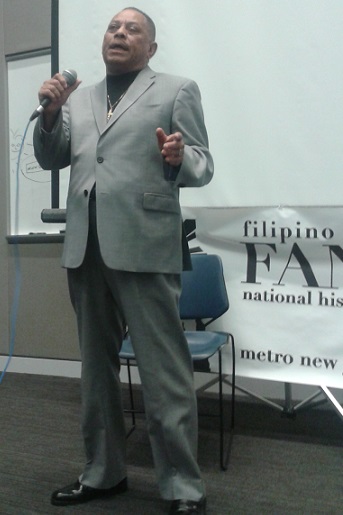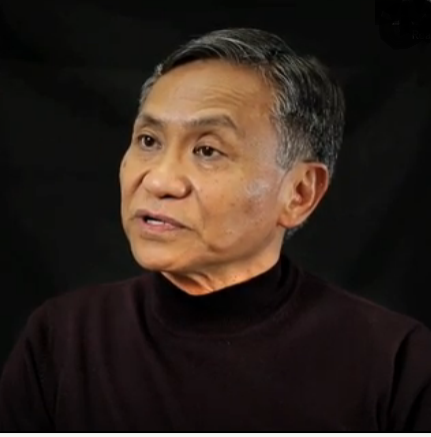Princeton exhibit: What’s next for Filipino American art?

By Vina Orden
On October 6, in honor of Filipino American History Month, Princeton University’s programs in American studies and Asian American studies presented the art exhibition, “300 Years in a Convent, 50 in Hollywood.”
The exhibit’s title alludes to reverberations of Spanish and American colonization in Filipino culture and society.
It features work by NExSE (for Northeast US by Southeast Asia), a collective of eight intergenerational Filipino American artists from New York, New Jersey, and Pennsylvania—Julio Jose Austria, Jeho Bitancor, Mic Boekelmann, Francis Estrada, Ben Iluzada, Ged Merino, Eva Marie Solangon, and Maria Stabio. They found each other in early 2020 through the Filipino American Artist Directory created by Janna Añonuevo Langholz to connect and uplift U.S.- and Philippine-based visual artists.
Entering the Lewis Center’s CoLab housing the exhibition, one is greeted by “Voices,” Jeho Bitancor’s sound installation, which features interviews in Tagalog and English with Filipino immigrants embodied in the space by their personal effects—a worn handbag, a pair of basketball shoes, a t-shirt from the 6th Aurora Surfing Challenge. A line from the surfer’s interview echoed out in particular to me: “Maganda ang pagiging kayumanggi ang kulay” (It’s beautiful being brown), considering the persistence of colorism among Filipinos, traceable to colonialism’s institutionalization of a racialized hierarchy in the Philippines.
Renaissance explorer narratives like Antonio Pigafetta’s chronicles of the Magellan-Elcano circumnavigation and the Boxer Codex as well as ethnological surveys and censuses undertaken at the turn of the 19th century by the Americans (including zoologist-turned-Secretary of the Interior of the Philippine Islands Dean Conant Worcester) distinguished between the “civilized” (or Christianized) versus “wild tribes” who were the “white man’s burden” to “uplift and civilize.”

Julio Jose Austria and Francis Estrada confront this colonial gaze in their work by referencing the human zoo on Coney Island, where indigenous Bontoc people were displayed in an “Igorrote Village” for white audiences’ entertainment. Austria’s painting, “Dog Eaters,” foregrounds the huddled Bontoc (rendered from a 1905 photograph) against an industrial backdrop, drawing parallels between the trafficking and exploitation of laborers then and Overseas Foreign Workers now and their disillusionment with the “American Dream.” Estrada’s “Escaping Dreamland,” which features a kayumanggi-colored mannequin branded with a map of Luna Park and surrounded by models of precolonial balangay vessels, at once critiques the American pleasure industry and reimagines alternate, emancipatory possibilities for the Bontoc.
Estrada’s other piece, “Amboy” (a contraction of American boy), is styled after the Boxer Codex, a 16th-century manuscript illustrating various “types” of Filipinos framed by real and imaginary flora and fauna from the islands. However, as a self-portrait, “Amboy” is a refraction. The subject isn’t framed rather is the gilt frame; the symbols aren’t decorative but meaningful (for instance, white baybayin characters painted over a red circle spell out “cola,” helpmeet to American imperialism); and the framed blankness signifies resistance to what W.E.B. DuBois called “double-consciousness, the sense of always looking at one’s self through the eyes of others” and to a fixed definition of “Filipino American.”
The challenges of connecting with this identity are explored by Mic Boekelmann, who left the Philippines at a young age and moved from place to place; and by Ben Iluzada, son of a Filipino immigrant who grew up apart from other Filipinos in Texas. Both artists work with abaca, or Manila hemp, once used to make Manila envelopes.

Boekelmann created “She’s Here”—a terno dress fashioned out of Manila envelope cutouts of sampaguita and kaluchuchi flowers (often associated with the spirits), along with words of affirmation from family elders in Tagalog and Bikolano—as “armor” for her daughter.
In contrast, Iluzada’s print on handmade, translucent abaca paper from his “Memories of the Barong” series intimates the clash of cultural values and expectations between father and son, with illustrations of the embroidery on a barong Tagalog, a buckle belt painted in opaque white, and a band of red etched with the words, “I want the most well-behaved kid.”
Patrick Flores, professor of art studies at the University of the Philippines, joined NExSE in conversation virtually from Manila. He brought up diasporic artists Carlos Villa (once told by a teacher at San Francisco Art Institute that the Philippines had no art history) and Santiago Bose, who acknowledged Spanish and American influences among Filipino artists but asserted that their incorporation of indigenous materials and concepts creates new artistic vocabularies and possibilities.
Situating NExSE within this lineage, one sees continuity in how the artists engage with history, colonization, migration, and diasporic identities. But one also glimpses what Flores anticipates as a “third moment” in Filipino American art—one that resists the flattening frameworks of nationalism or the precolonial / colonial / postcolonial and is grounded instead in subjective memories and experiences. The familiar becomes a springboard for artists and viewers alike to imagine new contexts, definitions, and futures.
Vina Orden is a writer, artist, and immigrants’ rights and human rights advocate based in New York City. Currently, she is Associate Editor for poetry and creative nonfiction at Slant’d magazine. She also is the co-host, along with Tamara Crawford, of The Lift Up, a monthly transatlantic conversation about books, writing, identity, and representation.











